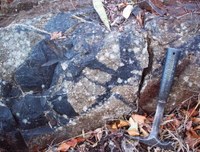3.4 billion-year-old fossils of microorganisms discovered
The findings, uncovered in South Africa, are the earliest known example of bacteria involved in the methane cycle: this discovery expands the frontiers of habitats that may have hosted the first forms of life on our planet, and could also prove useful in finding traces of life on other planets, starting with Mars.

An international research team has discovered fossil remains of bacteria involved in the methane cycle that lived 3.4 billion years ago within a hydrothermal system beneath the sea surface. It is the earliest example ever found of this type of microorganism: this marks a major step forward that expands the frontiers of habitats that may have hosted the first forms of life on our planet. And this could also prove useful in finding traces of life on other planets, starting with Mars.
The study – published in the journal Science Advances – is based on the analysis of samples taken from between two thin rock layers collected from the Barberton Greenston Belt, an area in eastern South Africa near the border with Eswatini and Mozambique, where some of the oldest and best preserved sedimentary rocks on our planet can be found.
‘We uncovered exceptionally well-preserved specimens of fossil microbes that had most likely colonised the walls of caves located several metres below sea level, which were created by jets of hot water fed by subseafloor hydrothermal systems,’ explains Barbara Cavalazzi, a professor at the University of Bologna and the main author of the study. ‘In fact, it is likely that some of the earliest ecosystems on our planet originated in subseafloor environments due to volcanic activity: we have uncovered the oldest evidence ever found of this kind of environment.’
The combination of cold seawater and hot subsurface hydrothermal currents is said to have shaped an environment rich in chemical compounds that may have contributed to the formation of different microhabitats capable of supporting life forms.
The microfossils discovered by the scholars have a carbon-rich outer part and a core, which is both chemically and structurally distinct. this configuration is reminiscent of cell division and, in particular, that of the cell membrane and intracellular material. The structures found are in the form of filaments: individual filaments (with submicrometric dimensions) were distributed over the lower part of the underwater cave, while groups of filaments occupied small loops hollowed out in the upper part.
In situ chemical analyses of the fossil structures have shown that most of the elements essential for life are present. Specifically, similarities have been observed (such as the presence of nickel concentrations) with modern Archaea, i.e. single-celled organisms that live in the absence of oxygen and use methane for their metabolism.
‘Although we knew that Archaean prokaryotes can be fossilised, there have been few examples to date: this finding may very well be the first trace of Archean fossils from the time when life first appeared on our planet,’ Cavalazzi adds. ‘This is also a breakthrough in the search for life on other planets: as we know, environments similar to those in which we found these microorganisms existed on Mars.’
The study was published in the journal Science Advances under the title “Cellular remains in a ~3.42 billion-year-old subseafloor hydrothermal environment”. Participants from the University of Bologna included Professor Barbara Cavalazzi, from the Department of Biological, Geological and Environmental Sciences, who coordinated the research, and Professor Assimo Maris, from the “Giacomo Ciamician” Department of Chemistry. This research was conducted with the support of Europlanet 2024 RI, which was funded by the EU’s Horizon 2020 programme (Grant No. 871149).
